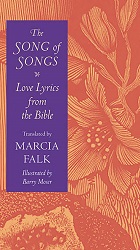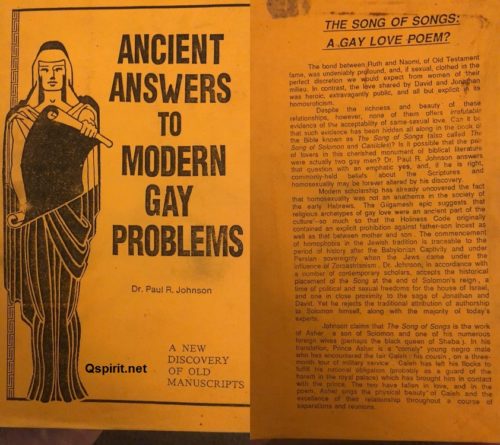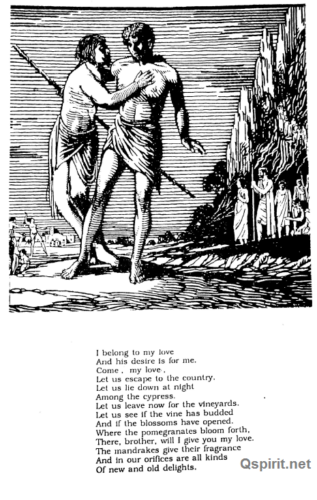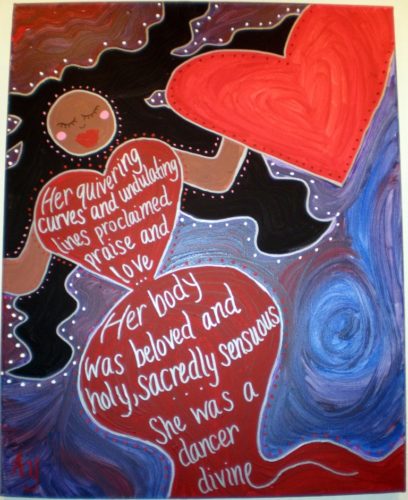Last Updated on January 8, 2024 by Kittredge Cherry

One of the greatest love poems of all time, the Bible Song of Songs, may have been written as same-sex love poetry. Paul R. Johnson translated it as “a gay love poem” and Angela Yarber sees it as erotic poetry between a woman and her female lover. Others are “queering” the scripture in a wide variety of creative or scholarly projects.
The song celebrates erotic love between two lovers. They do not have proper names, but the central figure is called “the Shulamite” in Song 6:13. This obscure Hebrew term is often understood to mean a person from Jerusalem.
Traditional theologians present the Song of Songs as a heterosexual love story. They explain away the eroticism of the Bible’s sexiest book as an allegory for love between God and a human soul, Yahweh and the Israelites or Christ and the church.
The song salutes not only sexuality in general, but black beauty in particular. In a popular line that didn’t make it into the lectionary, the scripture affirms, “I am black and beautiful.” (Song of Songs 1:5).
Many Protestant churches read Song of Songs (also called Song of Solomon or Canticles) 2:8-13 as the lectionary reading on July 9, 2023 and Sept. 1, 2024. This is the only passage from Song of Songs that appears in the three-year lectionary cycle.
 It’s actually confusing to identify who is saying what in the original Hebrew text for the Song of Songs. The gender of the speakers is uncertain in many cases, and the number of speakers is also unclear.
It’s actually confusing to identify who is saying what in the original Hebrew text for the Song of Songs. The gender of the speakers is uncertain in many cases, and the number of speakers is also unclear.
The two main characters are traditionally identified as Bride and Groom or the Beloved and King Solomon. Nobody knows who wrote the Song of Songs, but authorship is traditionally attributed to Solomon, who reigned in the tenth century BCE. He was the son of David, whose same-sex love with Jonathan is well documented.
Most translations of the Songs of Songs impose a heterosexual interpretation. One version that is not cluttered with hetero commentary is “The Song of Songs: Love Lyrics from the Bible,” translated by Marcia Falk, a feminist scholar who did her doctoral thesis on Song of Songs. Its meditative design leaves lots of white space and even includes the Hebrew text on facing pages.
While queer scholars wrestle with the Song of Songs, others create events such as Urban Adamah’s “Song of Songs Seder: Celebrating Queer Sexuality” or use it to inspire contemporary LGBTQ art and poetry.
Song of Songs translated as a gay love poem
Evangelical minister and scholar Paul Robert Johnson took the gay understanding to new heights in his revolutionary book “Ancient Answers to Modern Gay Problems: A New Discovery of Old Manuscripts: The Song of Songs, a Gay Love Poem?”
After 20 years studying the original Hebrew text, he concluded that both the Shulamite and the Shulamite’s lover were male. His translation reflects their same-sex love. In his version, the Shulamite is Asher, a black son of Solomon, and his beloved is a man named Caleh, a shepherd-soldier. Here is how Johnson translated Song of Songs 4:10-11:
“How delightful you are Caleh, My lover-man, my other half.
Your pleasing masculine love is better than wine.
The smell of your body is better than perfume.
Your moustache is waxed with honeycomb
Honey and milk are under your tongue.
The scent of your clothing is like the smell of Lebanon.”
Johnson’s book on the Song of Songs was published in 1990 by Fidelity Press, but is out of print and extremely hard to find. Online it has been known primarily through an often-republished 1995 review by Jim Kepner, founder of the International Gay and Lesbian Archives, and co-founder of ONE Institute. There is also a critical article debunking Johnson’s approach. It is actually easier to find an Italian translation of it, which is included in the book “Ecce homo: L’omosessualità nella Bibbia” by gay activist Massimo Consoli. Q Spirit founder Kittredge Cherry managed to track down a partial copy of the book for this article, with help from Hunter Flournoy of spiritjourneys.com.

“Ancient Answers to Modern Gay Problems: The Song of Songs, a Gay Love Poem?” by Paul R. Johnson is out of print and hard to find.
To translate the Song of Songs, Johnson relied on fragmentary pre-Masoretic texts. He found that editors had covered up the original same-sex love in Song of Songs. They made it appear to be heterosexual by hiding the Shulamite’s male name and changing the gender of the lover and beloved in many passages. Johnson tracked down an earlier, more accurate version on several scraps of the song with the Dead Sea Scrolls in Qumram cave #4.
The back cover of the book explains that the love between Jonathan and David or Ruth and Naomi implies acceptance of homosexuality during Biblical times, but does not provide irrefutable proof. The cover text continues:
“Can it be that such evidence has been hidden all along in the book of the Bible known as The Song of Songs (also called The Song of Solomon and the Canticles)? Is it possible that the pair of lovers in this cherished monument of biblical literature were actually two gay men? Dr. Paul R. Johnson answers that question with a resounding YES…. Johnson claims that The Song of Songs is the work of Asher, a son of Solomon and one of his numerous foreign wives (perhaps the black queen of Sheba). In his translation, Prince Asher is a ‘comely’ young negro male who has encountered the fair Caleh, his cousin, on a three-month tour of military service. Caleh has left his flocks to fulfill his national obligation (probably as a guard of the harem in the royal palace) which has brought him in contact with the prince. The two have fallen in love, and in the poem, Asher sings the physical beauty of Caleh and the excellence of their relationship throughout a course of separations and reunions.”

Love between men is pictured on a page from Johnson’s gay translation of Song of Songs 7:10-13: “I belong to my love and his desire is for me…”
Kepner’s review of the book concludes, “The Song of Songs now stands as the most explicit homoerotic love poem in the Bible, with clear naming of this thing going into that thing. Johnson’s small book is a must for all Jewish or Christian gays, though many might be too timid to abandon conventional hetero mistranslations.”
In a long and illustrious career, Johnson served as chairman of the board of the Lambdas, an early gay Christian organization dedicated to “informing our Christian and Jewish friends about the true nature of homosexuality as it relates to the church of our day,” and general moderator of Fidelity, “an association of gay, lesbian and homophile fundamentalists.” He pastored churches in Georgia, Illinois, New Jersey, and Washington state before moving to southern California. He then held various positions, including counselor and information director at the Los Angeles Gay and Lesbian Community Services Center. Johnson wrote many books, pamphlets and articles about Christianity and LGBTQ issues for the Advocate and other magazines. His other books include “Homosexuality and the Biblical Texts” and “Gays and the New Right: A Debate on Homosexuality.”
Claiming the Shulamite and her female lover in Song of Songs
Scholar and Baptist minister Angela Yarber’s research led her to the opposite conclusion. She believes that the Shulamite and her lover were probably both women.
Christian feminists generally see Song of Songs as an exemplary text with some of the Bible’s most positive representations of womanhood. The Shulamite is held up as a female role because she boldly affirms her body, her sexuality and erotic pleasure for its own sake. In contrast to other parts of the Bible, the Shulamite is honored for her sexuality, not attacked as a whore or forced into motherhood.

“Shulamite” by Angela Yarber
Yarber takes it further with her lesbian interpretation of the Song of Songs. She has done in-depth study of the Shulamite, painted her portrait and written extensively about her.
She explained her thinking in an interview with the Jesus in Love Blog / Q Spirit:
“The Shulamite is a dancer in Song of Songs 7, which says in part, ‘How beautiful are your sandaled feet, O prince’s daughter. The curves of your (quivering) thighs like jewels crafted by artist hands.’ I first discovered her when a dance historian mentioned her dance as a form of bellydance. This passing reference led me to translate, exegete, and publish an article about the Shulamite’s bellydance called ‘Undulating the Holy.’ Since bellydance is historically a dance performed by women in the context women, men were rarely permitted to witness bellydance. In other words, it would be an anachronism to propose that the lover doting upon the Shulamite was male. Additionally, many of the women in all female harems performed bellydance and engaged in same-sex relations with other women in the harems. Consequently, the queer history of bellydance, combined with the absence of male pronouns in the poem describing the Shulamite in Song of Songs 7 led me to conclude that the Shulamite’s lover was likely another female. What is more, the idea of homo and heterosexuality are not transhistorical essences, but instead are relatively recent socio-historical constructs. To say that there were strict sexual binaries in the ancient world in which the Shulamite lived would also be an anachronism. Sexuality was much more fluid. This dance and the poem describing the Shulamite are also very affirming of the female body. In these ways, the Shulamite is holy and empowering not just for women in general, but also for lesbians in particular.”
Her claims are backed up by solid scholarly research. She wrote her master’s thesis, “Embodied Liberation: Women in Ancient Israelite Dance,” at McAfee School of Theology in Atlanta, Georgia. Her Ph.D. dissertation at the Graduate Theological Union in Berkeley, California was on “Dancing Feet Find Holy Ground: Embodying the Feminine in the Dances of the World’s Religions.” She is founder and creative director of the Tehom Center (formerly called Holy Women Icons Project).
Yarber is also an artist, and she echoes the bellydance scripture in her icon of the Shulamite: “Her quivering curves and undulating lines proclaimed praise and love. Her body was beloved and holy, sacredly sensuous. She was a dancer divine.” The Shulamite is one of more than 100 voluptuous, vibrantly alive and life-giving women who appear Yarber’s colorful contemporary Holy Women Icons series. Since 2009, Yarber has painted more than 100 Holy Women Icons. These colorful, folk feminist icons are displayed in homes and galleries all over the world. They can also be found in her book “Holy Women Icons.”
Yarber shares more of her research and her own woman-centered translation of the passage about the quivering thighs (Song of Songs 7:1-4) in an article on the Feminism and Religion blog.
Song of Songs inspires LGBTQ people
Over the centuries the Song of Songs has been a touchstone for a wide variety of LGBTQ writers and theologians:
Bernard of Clairvaux, a medieval French abbot who had a passionate same-sex friendship, wrote a series of 86 sermons on the Song of Songs.
Victorian poet and painter Simeon Solomon, who was arrested in 1873 for sexual behavior with a man, found coded ways to connect the Song of Songs with male-male eroticism. His work is a popular topic with queer scholars today.
 The Song of Songs plays a small but important role in one of the all-time most popular gay novels, “The Front Runner” by Patricia Nell Warren. The 1974 novel is a love story between a track coach and his star athlete. It became the first contemporary gay fiction book to hit the New York Times bestseller list, selling 10 million copies in seven languages.
The Song of Songs plays a small but important role in one of the all-time most popular gay novels, “The Front Runner” by Patricia Nell Warren. The 1974 novel is a love story between a track coach and his star athlete. It became the first contemporary gay fiction book to hit the New York Times bestseller list, selling 10 million copies in seven languages.
Articles about “The Front Runner” almost always fail to mention the coach’s gay Christian side. The novel describes this bedroom scene of the gay lovers: “Before going to sleep we often lay propped in bed, reading…. I often read the Bible, letting its comfort and truth sink into me. Jesus had said that the last would be first. Society said that we were the last. It could be Jesus had meant the gays.”
Later the men create their own wedding service to make a formal public declaration of their love: “It consisted simply of quotes, each of us alternating. In his soft voice, Billy read from the teachings of Buddha… Then I read from the Bible, mostly the Song of Songs.”
For some LGBTQ people of faith, the dance of intimacy in Song of Songs may symbolize their feelings as they wonder whether to respond to God’s love while fearing rejection over their sexual orientation or gender identity.

LGBTQ Christian meme based on Song of Songs
A meme circulated on social media in 2021 generated some controversy even in the LGBTQ community by implying that the Song of Songs was a metaphor for Christ’s love of the LGBTQ community. Even a gay man called it “just pure blasphemy” when he first read:
“Words of Jesus to the
rainbow community:
You are altogether
beautiful, my darling;
in you there is no flaw.
— Song of Songs 4:7”
Queer Bible scholars explore Song of Songs
An almost overwhelming amount of queer Bible scholarship examines the Song of Songs. Here is a sampling of some chapters and articles:
Chapter on Song of Songs by Christopher King in “Queer Bible Commentary,” edited by Deryn Guest), Robert Goss, Mona West and Thomas Bohache.
“The Song of Songs for difficult queers: Simeon Solomon, Neil Bartlett, and A Vision of Love Revealed in Sleep” by Duc Dau, a chapter in “Queer Difficulty in Art and Poetry: Rethinking the Sexed Body in Verse and Visual Culture.”
“The Song of Songs in the History of Sexuality,” a chapter in “God’s Beauty Parlor: And Other Queer Spaces in and Around the Bible” by Stephen D. Moore.
“Biblical Drag: Performing Gender with the Song of Songs” by Max Brumberg-Kraus (United Theological Seminary)
“Penderecki’s Iron Maiden: Intimacy and Other Anomalies in Canticum canticorum Salomonis” by Heidi Epstein, a chapter in “Bible Trouble: Queer Reading at the Boundaries of Biblical Scholarship”
“Promethea’s Song of Songs” by Yael Klangwisan, a chapter with a bisexual interpretation in “Sexuality, Ideology and the Bible: Antipodean Engagements”
“Queer Readings of the Song of Songs” by Karin Hügel (Journal of the European Society of Women in Theological Research)
___
Top image credit: A heart shaped shadow is cast on a Bible open to the Song of Solomon in “Book of Love” by Jonathan Thorne (Wikipedia)
___
This post is part of the LGBTQ Saints series by Kittredge Cherry. Traditional and alternative saints, people in the Bible, LGBT and queer martyrs, authors, theologians, religious leaders, artists, deities and other figures of special interest to lesbian, gay, bisexual and transgender and queer (LGBTQ) people and our allies are covered.
This article was originally published on Q Spirit on Sept. 6, 2021 was expanded with new material over time, and was most recently updated on July 8, 2023.
Copyright © Kittredge Cherry. All rights reserved.
Qspirit.net presents the Jesus in Love Blog on LGBTQ spirituality.







Thanks so much especially for that list of resources at the end! <3 Lovely work.
Nigra Sum sed Formosa is an antiphon in the Vespers of the Blessed Virgin.
It is part of a Suite in 15 movements for Organ by Marcel Dupre. the movement is extremely peaceful and in the seminary it was frequently used as the Organ Processional on the seminary patronal Feast of the Immaculate Conception. There are also vocal settings of this text as anthems or motets. One example in the setting by Pablo Casals
So this article quotes two LGBT authors, a gay man who inevitably thinks the Song of Songs refers to two male lovers and a lesbian who inevitably thinks it refers to two female lovers, both of them insisting that they have solid proof to reach opposite conclusions. LOL
This stuff sounds like a parody of itself.